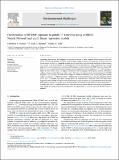| dc.description.abstract | Technology development has triggered the demand for the use of radio frequency electromagnetic fields (RF-EMF). The growing demand for mobile communication, digital industrial evolutions and social services have forced service providers to expand the wireless network technology with additional installation of base stations. The increase in the use of RF-EMF for communication such as television (TV), radio, wireless services, internet and cellular communication have also increased the exposure levels of human to RF-EMF. However, exposure RF-EMF can have advance health effect to human and environmental radiation pollutions. RF - EMF exposure is higher in areas where people are highly concentrated such as hospitals, market places, schools, universities, colleges, shopping malls, than in any other region. Therefore, it is important to be concerned about the RF-EMF exposure to public in order to ensure that the exposure is under the allowable limits. In this study, power density values are measured at different locations in Dodoma, Dar es Salaam and Mwanza where the population density is too high, to examine their power density levels. An Artificial Neural Network (ANN) and Multi Linear Regression (MLR) models are developed to estimate the total power density values of different locations from RF-EMF exposure sources. The results show that both models are significant with coefficient of determination R2 = 0.999 for MLR and R2 = 0.966 for ANN model. The results of these models show how the study are of significance and valuable for monitoring and evaluating, hence the optimization of exposure dose from RF-EMF sources is adhered. | en_US |

